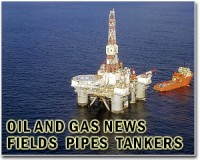 |
Tehran (UPI) Jan 14, 2009 As Iran faces a growing Western threat of economic sanctions over its controversial nuclear program, Tehran has been quietly building up its defenses and looking eastward. On Jan. 6 it opened a natural gas pipeline linking Iran's northern Caspian region with Turkmenistan's vast fields in Central Asia that will help it defy the West. At first sight, the 115-mile pipeline is a modest enough undertaking. Initially it will carry 8 billion cubic meters of gas from Turkmenistan to Iran. But analysts see this as the precursor of major shifts in energy production and distribution involving Russia, China, Iran, Central Asia and the European Union. "We are witnessing a new pattern of energy cooperation at the regional level that dispenses with Big Oil," observed M. K. Bhadrakumar, a former Indian ambassador to the Soviet Union, Afghanistan, Uzbekistan and Turkey and now a geopolitical analyst. "Russia traditionally takes the lead. China and Iran follow the example. Russia, Iran and Turkmenistan hold respectively the world's largest, second-largest and fourth-largest gas reserves. "The matter is of profound consequence to the U.S. global strategy." That will help Iran provide gas for its northern provinces, which will be a vital service if the tough new sanctions the Americans and their European allies are supposedly drawing up are endorsed by the United Nations because of "Iran's persistent failure to meet its international obligations." But later this year the volume of gas in the pipeline will rise to 12 bcm and then to as much as 18-20 bcm in 2011. This will allow cash-strapped Iran to free up its own gas production in the south for export and defy sanctions. The new pipeline will run from the Dauletabad fields in southwestern Turkmenistan to the Khanigaran gas processing plant in Iran's Khorasan province. That complements another pipeline, laid in 1997, that runs from southwestern Turkmenistan to Iran. It has an annual capacity of 8 bcm of gas for the Islamic Republic. But there is even more in this for Tehran. With growing volumes of Turkmeni gas flowing into Iran, Turkey, its northwestern neighbor, is interested in receiving more Turkmeni gas via Iran, or Iranian gas freed up by the deliveries from Turkmenistan. Turkey, a NATO member and long considered a pro-Western ally, is currently engaged in a bold new diplomatic strategy of forging new alliances in the Middle East and into Central Asia. Given its strategic location between Europe and Asia, it has long had its eye on becoming the key hub for transporting energy from Russia, Central Asia and Iran to Europe. According to some reports, Tehran claims to have a deal with Ankara to transport Turkmeni gas to Turkey via a 1,300-mile pipeline that runs from Tabriz in northwestern Iran to Ankara. Boosting the flow of Turkmeni gas via Iran and Turkey would mean that Europe would be a major beneficiary at a time when it is striving to lessen its dependence on Russian gas supplies. U.N. sanctions would create an obstacle in that regard, but Europe's determination to break free from Russian gas supplies would be a powerful incentive to find creative ways around U.S.-led efforts to bring Iran's economy to its knees. Ankara could route the new gas supplies through the Nabucco gas pipeline designed to run 2,000 miles from the Caspian Sea through Turkey to Austria. The goal is for that pipeline to ease Europe's reliance on Russia or facilities controlled by its energy giant Gazprom. There is a fly in the ointment though. Iraqi Prime Minister Nouri al-Maliki offered last summer to supply Nabucco with 15 bcm of gas a year from 2015. If that comes off, the Americans, determined to leave a viable Iraqi state behind them, would undoubtedly throw their weight behind such a project, if only to tighten the squeeze on Iran. Still, U.S.-based security consultancy Stratfor noted that "Iran's geographical location makes it a very attractive alternative to Russia for energy supplies destined for Europe, and it has heavy volumes of its own natural gas and vast untapped reserves. "Of course, Iran's controversial nuclear program creates massive political complications in getting Iran involved in such a deal right now, but this is not to preclude participation in the future."
Share This Article With Planet Earth
Related Links Powering The World in the 21st Century at Energy-Daily.com
 Nature-for-oil plan in Ecuador in jeopardy
Nature-for-oil plan in Ecuador in jeopardyQuito (AFP) Jan 14, 2010 A plan to leave major oil reserves in Ecuador's Amazon basin untouched in return for a major international donation was in jeopardy Thursday after Foreign Minister Fander Falconi resigned. Falconi spearheaded the 3.5-billion-dollar initiative until President Rafael Correa on Saturday called the payment conditions he was negotiating with the United Nations "outrageous." Correa even threat ... read more |
|
| The content herein, unless otherwise known to be public domain, are Copyright 1995-2009 - SpaceDaily. AFP and UPI Wire Stories are copyright Agence France-Presse and United Press International. ESA Portal Reports are copyright European Space Agency. All NASA sourced material is public domain. Additional copyrights may apply in whole or part to other bona fide parties. Advertising does not imply endorsement,agreement or approval of any opinions, statements or information provided by SpaceDaily on any Web page published or hosted by SpaceDaily. Privacy Statement |